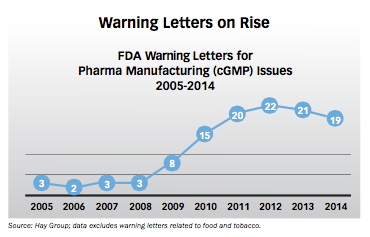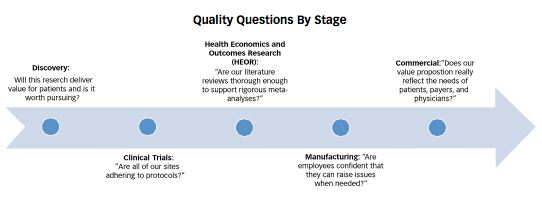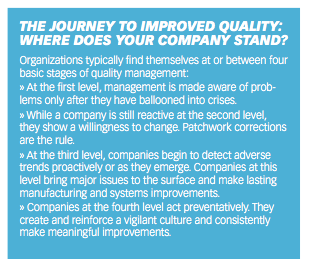Manufacturing’s True North: The Quality Compass
Pharmaceutical Executive
The need for biopharma executives to combine a "culture of quality" with value-added processes and improvements in the area drug manufacturing is critical. Here are steps and strategies than can help.
In pharmaceutical manufacturing, tales of quality failure follow a familiar pattern. A manufacturing site-often offshore-finds itself on the receiving end of regulatory action for such violations ranging from missing or manipulated test data and failure to submit field alert reports, to lack of compliance with current good manufacturing practices (cGMP). Duly warned, executives then take steps to improve. Sometimes, this tale ends happily; often it does not. Issues recur, and companies are left to wonder whether their organization is simply fated to have problems maintaining quality.
Biopharma executives who create a culture of quality in their organizations can take control of their own quality story-and thus craft a greater number of stories that have happy endings. What do we mean by a "culture of quality"? A culture of quality is the sum of the good habits possessed by every member of an organization. When these behaviors are in place, work exceeds the standards not only of regulators but also of patients, providers, and payers. In other words, in a culture of quality, every action in the biopharma company, from the most routine to the most novel and inventive, aims to exceed standard practice.
Why a culture of quality is critical
There are three major reasons why executives need to build a culture of quality: the cost of quality failure, increased regulatory activity, and the FDA’s changing approach to quality oversight.
Cost. Inattention to quality is costly. In the extreme case of a consent decree, penalties have been known to top half a billion dollars. But penalties alone do not provide the full picture. A 2013 McKinsey study of the medical device industry estimated that taken together, routine quality control, “non-routine quality events,” and revenue losses from non-routine quality events cost that industry $17 billion to $26 billion annually, a figure that represents 12% to 18% of revenue. But the report also pointed out that improving quality has clear benefits. It cited the example of a medical device company that reduced warranty costs by €21 million per year through reliability engineering. In addition, the company was able to increase its capacity because of because of supplier and manufacturing improvements, and revenue grew by approximately €30 million per year.
FDA rethink. Over the last 10 years, FDA activity has increased noticeably. The FDA issued more than six times the number of warning letters for manufacturing in 2014 than it issued in 2005 (see chart).

The spike in warning letters doesn’t tell the whole story, though. Between 2010 and 2011, field alert reports nearly doubled from approximately 800 to slightly less than1,600. In that same period, OTC recalls rose from 336 to 652, while prescription drug recalls rose from 479 to 605. Drug shortages also climbed: from 178 shortages in 2010 and 251 in 2011. In this same period, shortages of sterile injectables more than doubled, from 74 to 183.
A changing approach to quality. Finally, these numbers are among the factors that have prompted the FDA to rethink its approach to quality oversight and to shift the emphasis of its investigations from the paper trail to product quality. Other factors include “unacceptably high” occurrences of problems attributable to defects in product and process design, an increase over the last decade in the number of post-approval supplements received for review, and a disproportionate amount of attention devoted to low-risk products.
An attempt to place quality review, inspection, and evaluation under one roof, the the Office of Pharmaceutical Quality (OPQ) is a step in this direction. On the horizon is an approach to define and measure product-specific quality metrics in order to monitor product performance (including positive and negative trends). Hypothetically, collecting quality metrics will allow regulators and manufacturers to devote more resources to at-risk manufacturing sites while reducing the inspection burden on lower-risk sites.
What do these developments add up to? The cost of quality failures, the jump in warning letters (regardless of whether the jump is a result of a downward trend in quality or more vigorous regulatory action), and the establishment of the OPQ are signs that quality needs to become more of a focus in biopharma organizations. From the Board level down, biopharma leaders should ask themselves, “What if we placed manufacturing quality at the center of our competitive strategies? What kind of culture would develop, and what business results would ensue?”
Obstacles to change
It’s not much of an overstatement to say that, historically, manufacturing has been a strategic afterthought-executional drudgery after the high drama of research and commercialization. However, such benign neglect of manufacturing is misguided. Because quality and reliability matter significantly to patients, they should be central to every company’s commitment to health. What’s more, a focus on quality also leads to cost savings realized through process improvements. In fact, one company saved $50 million by improving quality across two sites.
To capture cost savings and improve quality-outcomes all biopharma executives wish to achieve-it is critical to make quality central to an organization’s culture. Nevertheless, in most companies, significant barriers stand in the way of creating a culture of quality. One such barrier is a misconception that manufacturing is not a major strategic concern. This misguided view holds that quality is extrinsic to the broader mission of the biopharma company and not the shared responsibility of every area of the organization.
Compounding this misconception is a sense that manufacturing is not an asset but a vulnerability. Although an unhelpful way to look at manufacturing, this view is understandable in light of high-profile penalties over the years. During the past decade and a half, the FDA has held numerous pharmaceutical companies accountable for GMP violations, through legal action and by imposing stiff penalties: in one case, a $500 million penalty and a consent decree that required one company to shut down manufacturing for over 50 different products. At the time this was the largest set of penalties the FDA had ever administered.
Lost opportunity to innovate
Surely, failure to properly balance operational performance, cost, and quality leads to regulatory issues, financial cost, and the loss of public confidence. But such failure has another cost: lost opportunity to innovate. While biopharma companies have generated notable scientific innovations over the last two decades, advancements in manufacturing have been comparatively less dramatic. Although lean production techniques have boosted labor productivity and cut variable costs, pharma trails other industries (e.g., food, consumer goods) in modernizing manufacturing processes.
Given that process improvements represent such low-hanging fruit, executives should treat manufacturing not as an occasion for risk but as an opportunity to innovate. By combining a culture of quality with value-added processes and improvements, companies will reduce compliance issues and boost efficiency, reduce risk and increase revenues. With a culture of quality in place, manufacturing will become a source of competitive advantage.
Doing it right: Quality across the whole organization
To realize this competitive advantage, mindset and culture must evolve so that quality becomes central to how both innovator and generics companies deliver on their value propositions. This evolution requires emphasizing quality not just in manufacturing but in every part of the organization.
An important first step in building such a culture is to understand manufacturing as central to the company’s mission. The self-image of a biopharma company includes many elements, and scientific and medical excellence is usually chief among them. Excellence in operations is another, as is excellence in business strategy.
But biopharma leaders should not forget that the goal of these many sophisticated skills is a physical product, one that a patient will swallow or a physician inject. Indeed, the myriad complex cognitive acts necessary to bring a drug to market have a physical, material goal, and if the tangible product is defective, these intellectual efforts, their sophistication notwithstanding, come to naught. Comparisons with art making, where an artist works to realize a mental concept in material form, spring to mind-Failing to include manufacturing as an essential component of the value chain is like Donatello or Rodin ignoring the quality of the bronze in which their sculptures were cast, or a great director filming a brilliant script without considering the skills of the actors.
For biopharma companies, then, the execution needs to be present in the concept from the beginning, which in practical terms means this: quality must become the shared responsibility of every part of the organization, a part of every link in the value chain. When a quality mindset inheres in all parts of the company, quality in manufacturing will become second nature.
No matter what department they’re in or what their role is, everyone needs to prioritize quality, which must be baked into the organization end-to-end. Although scientists working in discovery or health economists calculating quality adjusted life year (QALY) figures have little direct influence on the quality of manufacturing, per se, their actions, nevertheless, have important indirect effects; actions add up to a culture that supports manufacturing quality. While quality means something different in every part of a company, when enough people make it a priority, it becomes a company norm, a habit reinforced by positive peer pressure.
Which is to say, every area of a biopharma company can contribute to a culture of quality. Questions such as those illustrated in the figure below will help different parts of the organization prioritize quality in the ways that make sense for their various roles and functions.

How leaders set the tone
A culture of quality creates an environment hospitable to excellence in manufacturing, but for such a culture to take shape leaders at the highest levels of the company-from the CEO and board levels down-must first set the tone. In word and deed, they must send the right messages about quality. By raising the organizational profile of manufacturing, for example, they will send unmistakable signals that quality matters. Messages about quality must be clear and consistent.
Down the organizational chart, among managers, change entails a willingness to train employees to address quality issues, and then to entrust them with the responsibility to do so. (In a culture of quality, employees exert control and influence at key process points.) It’s up to managers to open clear lines of communication and create an atmosphere of trust so that employees feel secure and confident in reporting issues. Certainly, employees will make a few mistakes along the way, but in the end, quality will become habitual throughout the organization. Finally, managers need to set expectations for quality. They need to communicate that quality is a priority, encourage the habits that lead to quality, and hold employees accountable for quality when evaluating them.
One example: data integrity is essential. If leadership sincerely places the proper emphasis on quality, entrusts employees to focus on quality, and celebrates actions to assure quality, the outcome will reduce breaches in compliance that will eventually be discovered and have negative regulatory and compliance consequences.
Entrusting employees with responsibility for quality sounds great in theory. But many readers might wonder where to find employees with the skills to handle it. Finding the right talent is undoubtedly a challenge. However, leaders can overcome this hurdle by investing in the talent they already have. Creating a culture of quality means treating employees as key assets and investing in their futures. It means giving them the technical skills and training to maintain high standards and to understand how the whole manufacturing process works end-to-end.
Imparting this sense of the whole requires communication from management, which may take the form of newsletters featuring articles about different areas of the business, lunch-and-learns, and one-on-one conversations. In addition, research published in the Harvard Business Review suggests that positive peer pressure is important in rallying employees around a quality culture. For example, managers might organize friendly competitions to see which groups can deliver the most consistently high-quality results.
Leadership styles for quality
In the end, leaders must treat employees as assets whose knowledge, experience, and judgment are critical to the business. Executives should become aware of the styles of

leadership they use (if they aren’t already) and, as needed, add more tools to their toolkit. This is because using the right leadership styles is vital in creating a trusting, engaging climate that encourages bringing issues to the fore and taking action when necessary.
The best styles to ensure quality are those that make employees feel that their managers have their best interests at heart. Designated “resonant” by Daniel Goleman in his book Primal Leadership, these styles elicit the positive emotions that bring out the best in people. What Goleman calls the “dissonant” styles, by contrast, rely on negative emotions like fear and anxiety. In brief, the four resonant styles are 1) visionary (showing everyone what the big picture is), 2) affiliative (building genuine relationships), 3) coaching (helping people become better), and 4) democratic (listening to make sure the team’s best ideas come to the surface).
Note that certain leadership styles-the affiliative and visionary-are more effective than others in setting the stage for quality. Why? The affiliative style creates harmony and good relations among team members, helping employees feel engaged and, when they need to act on their own, authorized. A visionary style establishes a clear quality standard or goal, communicates it persuasively to the team, and moves the team toward it.
The dissonant styles, pacesetting (relentlessly demanding excellence) and commanding (insisting on immediate compliance), have their place in certain situations-in crises, for example. But when overused, these styles have a negative effect on climate. This is important because quality problems-which by their nature tend to require leaders to use the pacesetting and commanding styles-may result in climates that generate further quality problems. When urgent action is needed after a warning letter, for example, the pacesetting and commanding styles are appropriate. But, these styles hurt the climate and often lead to employee disengagement, decreased quality, and more regulatory action. The cycle starts anew. The commanding style in particular leads to another problem-it creates a climate of fear where employees worry about retribution. In such a climate, they are reluctant to challenge the status quo or flag issues. In this way, the commanding style backfires by driving quality issues underground.
Aligning goals is key
Given the increasing pressure on biopharma companies’ margins, some executives might feel that the focus on quality we advocate is a luxury rather than a necessity. Naturally, we recognize that life science companies are businesses and have financial performance goals. But we firmly believe these goals are consistent with the need to have a culture of and focus on quality. The goal is to produce safe and effective medicines with each and every batch made. What’s more, our experience suggests that most companies have not taken full advantage of operational improvements that will improve quality and bring cost savings.
Nevertheless, leaders might also wonder how they can devote resources to building a culture of quality when so many other areas of the business demand attention. The industry has faced tremendous financial pressure over the last few years, and as the very business model of the biopharma company adapts to new realities, calls abound for innovation and transformation in every area of the business.
In such a climate, how are executives to know where to focus their efforts? On discovery and R&D? The sales force? health economics and outcomes research (HEOR)? Big data capabilities? The answer, of course, is all of the above.
In spite of all of this complexity, we want to make the case that manufacturing provides yet another area where savvy leaders can innovate. Any company that builds-and sustains-a genuine culture of quality across all areas of the business will be delivering innovation at its most practical.
Ian Wilcox is Vice President and Global Managing Director, Life Sciences, at the Hay Group. He can be reached at ian.wilcox@haygroup.com. Conrad J. Heilman, PhD, is President & CEO of Tunnell Consulting Inc. He can be reached at heilman@tunnellconsulting.com.

Addressing Disparities in Psoriasis Trials: Takeda's Strategies for Inclusivity in Clinical Research
April 14th 2025LaShell Robinson, Head of Global Feasibility and Trial Equity at Takeda, speaks about the company's strategies to engage patients in underrepresented populations in its phase III psoriasis trials.
Bristol Myers Squibb’s Cobenfy Falls Short in Phase III Trial as Add On Therapy for Schizophrenia
April 23rd 2025In the Phase III ARISE trial, Cobenfy administered as an adjunctive treatment to atypical antipsychotics for patients with inadequately controlled schizophrenia did not achieve statistically significant improvements.
Key Findings of the NIAGARA and HIMALAYA Trials
November 8th 2024In this episode of the Pharmaceutical Executive podcast, Shubh Goel, head of immuno-oncology, gastrointestinal tumors, US oncology business unit, AstraZeneca, discusses the findings of the NIAGARA trial in bladder cancer and the significance of the five-year overall survival data from the HIMALAYA trial, particularly the long-term efficacy of the STRIDE regimen for unresectable liver cancer.
Expanding Immune Response Testing to Support Vaccine Development
April 22nd 2025Nigel McCracken, chief operating officer, Virax Biolabs, discusses the expansion of its ViraxImmune platform into areas such as transplant monitoring, vaccine efficacy, latent virus reactivation, and CAR T cell therapy.